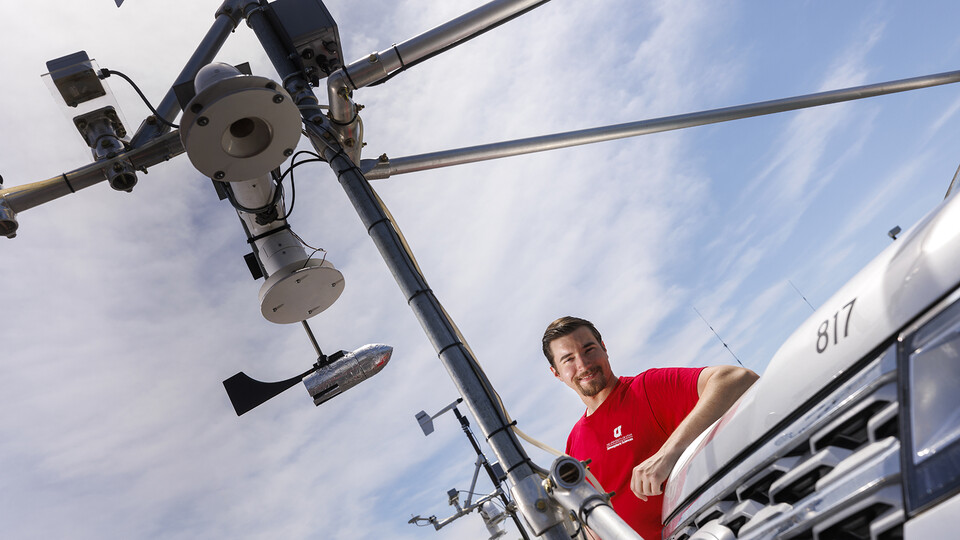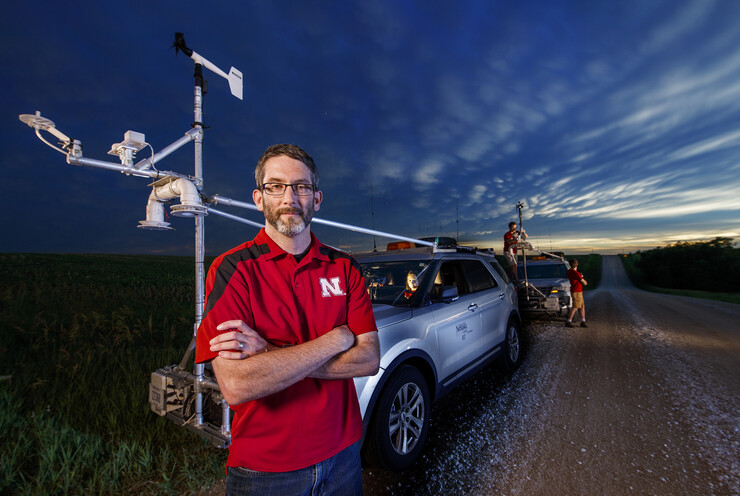· 5 min read
Mayfield tornadoes inspire TORUS researcher

After tornadoes hit near his family home outside Mayfield, Kentucky, meteorology student Dallas McKinney decided to learn more about the weather forces that create the often-lethal storms.
That curiosity led him to join the Nebraska-led TORUS team that departed May 16 to track storms through June 17 across the Great Plains from Texas to the Canadian border. The team will deploy a broad suite of instrumentation in a quest to better understand why supercell thunderstorms sometimes form tornadoes. From a position in Salina, Kansas, the 17-member TORUS team will move out May 17 to a likely site for a supercell storm, with the aim of being able to easily move each succeeding day to a new location where storms are forecasted.
The project's goal is to enable meteorologists to more accurately forecast when tornadoes will strike — and improve public safety by reducing false alarms, according to Adam Houston, the University of Nebraska-Lincoln atmospheric scientist who leads the $4 million TORUS project. In fact, the 2022 field research session has added a new feature, delivering real-time data to the National Weather Service for use in forecasting. The information will be made available at a website for use by National Weather Service forecast offices throughout the region.
In December 2021, Kentucky was “ground zero” for a burst of tornadoes that killed 76 people in the state, including 22 in Graves County, where Mayfield is located. The Mayfield death total included nine people at work at a candle factory destroyed by the storm. More than 100 workers were in the factory the night of the storm, and some observers have questioned whether there was sufficient warning to get more people to safety. Company representatives have said all safety protocols were followed.
McKinney, 25, is pursuing a master’s degree in atmospheric science at the University of Utah. Tornadoes are rare in Utah and his research involves lake-effect snow and how it interacts with nearby mountains. McKinney said his interest in tornadoes originally was spawned by an EF3 tornado that hit Mayfield in May 2016.
An EF3 tornado is in the mid-range of the Enhanced Fujita scale that the National Weather Service uses to quantify the strength of a tornado. An EF3 tornado will have estimated wind speeds between 136 and 165 mph.
While his family escaped harm in both events, McKinney said the storms show how important it is for meteorologists to understand supercell storms, which differ from ordinary thunderstorms in part because they are capable of spawning long-lasting, destructive tornados.
“Both of those storms, the one in 2016 and the one in December, resulted from supercell thunderstorms,” McKinney said. “Supercells previously were uncommon in Kentucky and are now becoming more common. Published research has shown Tornado Alley is moving eastward from Oklahoma, Kansas and Nebraska toward Kentucky, Alabama and Mississippi. To become a better forecaster, I need to understand these storms.”
For more than 15 years, Houston has investigated the structure of supercell tornadoes using coordinated observation technologies. It requires driving and flying as close as safety allows to potentially violent weather.
“It is not possible to fully characterize and describe the structure of the storms in any other way,” Houston said. “That’s why no one has done it yet.”
Since 2018, TORUS, which is an acronym for Targeted Observation by Radars and UAS of Supercells, has included scientific groups from the University of Nebraska–Lincoln, University of Colorado, Texas Tech University and the National Severe Storms Laboratory based at the University of Oklahoma. Three-fourths of its funding comes from the National Science Foundation and the remainder from the National Oceanic and Atmospheric Administration.
Due to the COVID-19 pandemic, the 2022 season is the first time the team will be able to conduct field research since 2019. The interim allowed Houston and his team to review other recent research in the field. In December, the TORUS team held a focus group with 21 forecasters from the National Weather Service to learn more about the data needed to improve tornado forecasting.
McKinney holds a bachelor’s degree in meteorology and geographic information science from Western Kentucky University. He became aware of TORUS when he heard Houston speak at the American Meteorological Society’s annual conference in Boston in January 2020. He planned to join Houston’s team in summer 2020, before he started his graduate studies at Utah, but the field research season was canceled because of the global pandemic.
Now his stint with TORUS will be one of the last things he does before completing his master’s degree this September. He expects his experience with GIS and meteorology will be an asset to the team as far as navigating the chase vehicles.
McKinney was a community college student in Paducah, Kentucky, when the May 2016 tornado struck. He followed the storm via radar and made his own forecasts of where it would go, echoing National Weather Service reports. He didn’t chase the storm, but he was able to observe it firsthand when he drove near its path to pick up his younger brothers from school.
“I was very much an amateur,” he said. “But I’ve been interested in weather as long as I can remember. When most kids were watching cartoons, I was watching the Weather Channel.”
After finishing his degree, McKinney hopes to become a meteorologist with the National Weather Service.
Learn more about the TORUS project and follow their progress via social media here.
The PIs are very grateful for the TORUS participants who executed data collection that will make possible scientific discovery for many years. This year TORUS had coordinated deployments on 18 supercells, 7 of which were tornadic, over 16 deployment days between 5/17 and 6/15. pic.twitter.com/ZXWvT81pDb
— TORUS (@TORUSupercell) June 17, 2019









